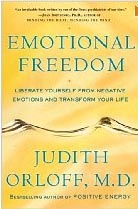
 Emotional Freedom
Emotional FreedomLiberate Yourself from Negative Emotions and Transform Your Life
Reviewed July 22, 2009.
Harmony Books, New York, 2009. 401 pages.
Starred Review.
Judith Orloff defines emotional freedom by saying,
It means increasing your ability to love by cultivating positive emotions and being able to compassionately witness and transform negative ones, whether they're yours or another's. . . . With true emotional freedom, you can choose to react constructively rather than relinquishing your command of the situation whenever your buttons get pushed, as most people do. This lets you communicate more successfully and gain more confidence in yourself and empathy for others. Then you own the moment no matter whom or what you're facing.
This book doesn't present a simplistic approach. I like that about it.
Recently, a friend asked me when I'm going to forgive my husband. I was taken aback. I thought I already have forgiven him! But on thinking about it, forgiveness from a deep wound is complicated. You still have pain from the wound. New things happen that bring up new anger. If lies were involved, there's a certain need to discover truth. Then there's fear of being hurt again, especially if the person who hurt you is unrepentant.
Judith Orloff acknowledges the complicated nature of emotions, and presents tools for helping you face the negative ones and begin transforming them into positive ones.
The word transformation sums up her approach. She's not trying to make you give up or suppress your negative emotions. She's simply giving you tools to begin transforming them.
She specifically looks at seven important transformations in the seven last chapters:
Facing Fear, Building Courage
Facing Frustration and Disappointment, Building Patience
Facing Loneliness, Building Connection
Facing Anxiety and Worry, Building Inner Calm
Facing Depression, Building Hope
Facing Jealousy and Envy, Building Self-Esteem
Facing Anger, Building Compassion
Another nice thing about the book is that, while reading it through gives you good reminders of helpful ways to lift your emotions, when you actually find yourself in the negative emotion, you can use the book as a cookbook of ideas to help you transform it.
As a physician, she has some ideas of how your body and biology can help you. For example, if you're lonely, boost your oxytocin. If you have trouble with fear, lower your intake of caffeine.
As an empath, she also gives you ideas for letting your intuition help you. As well as some ideas about spirituality, energy flow, and psychology as they relate to these emotions.
Altogether, this book has many wise ideas about dealing with negative emotions, and I imagine at least one of these ways of looking at them is one you've never considered before.
I also like that she doesn't say that negative emotions are bad and positive ones are good. The use of "negative" and "positive" have more to do with how they feel. She acknowledges that everyone has negative emotions aplenty. But she helps us use the energy they bring with them to transform into a more powerful and more pleasant emotional state.
I'm not sure how much of this book I really grasped on the first reading. As I said, I think I'd like to pick it up the next time I'm feeling depressed, for example, and think about her ideas for using that energy to move into hope.

